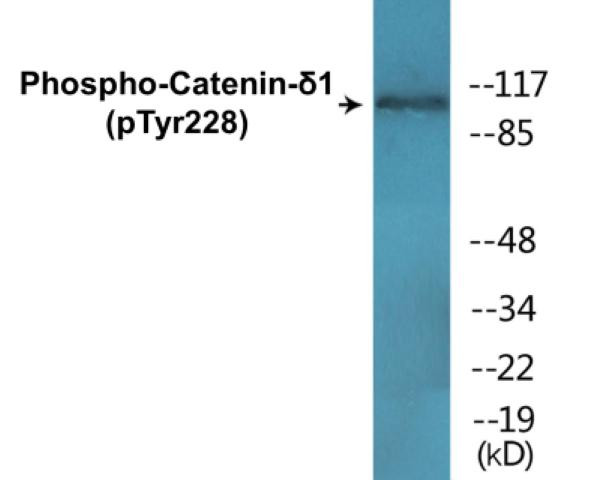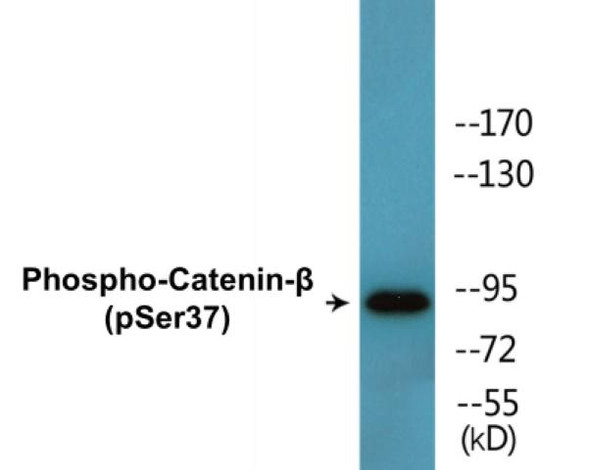Description
Catenin-delta1 (Phospho-Tyr228)Colorimetric Cell-Based ELISA Kit
The Catenin Delta1 Phospho-Tyr228 Colorimetric Cell-Based ELISA Kit is specifically designed for the accurate detection of phosphorylated Catenin Delta1 protein levels in cell lysates. This kit offers exceptional sensitivity and specificity, allowing for precise and reproducible results, making it ideal for a wide range of cellular signaling research applications.Catenin Delta1 is a key protein involved in cell signaling pathways and plays a crucial role in various cellular functions such as cell adhesion and migration. Phosphorylation of Catenin Delta1 at Tyr228 is known to regulate its function and can impact cellular processes such as cell proliferation and differentiation.
Understanding the phosphorylation status of Catenin Delta1 is essential for studying its involvement in biological processes and its potential role in disease development.With the Catenin Delta1 Phospho-Tyr228 Colorimetric Cell-Based ELISA Kit, researchers can accurately measure the levels of phosphorylated Catenin Delta1 in cell lysates, enabling a deeper understanding of its regulatory mechanisms and potential therapeutic targets. This kit provides a reliable and convenient tool for studying cellular signaling pathways and investigating the role of Catenin Delta1 in various cellular processes.
| Product Name: | Catenin-delta1 (Phospho-Tyr228) Colorimetric Cell-Based ELISA |
| Product Code: | CBCAB01410 |
| ELISA Type: | Cell-Based |
| Target: | Catenin-delta1 (Phospho-Tyr228) |
| Reactivity: | Human, Mouse, Rat |
| Dynamic Range: | > 5000 Cells |
| Detection Method: | Colorimetric 450 nm |
| Format: | 2 x 96-Well Microplates |
The Catenin-delta1 (Phospho-Tyr228) Colorimetric Cell-Based ELISA Kit is a convenient, lysate-free, high throughput and sensitive assay kit that can detect Catenin-delta1 protein phosphorylation and expression profile in cells. The kit can be used for measuring the relative amounts of phosphorylated Catenin-delta1 in cultured cells as well as screening for the effects that various treatments, inhibitors (ie. siRNA or chemicals), or activators have on Catenin-delta1 phosphorylation.
Qualitative determination of Catenin-delta1 (Phospho-Tyr228) concentration is achieved by an indirect ELISA format. In essence, Catenin-delta1 (Phospho-Tyr228) is captured by Catenin-delta1 (Phospho-Tyr228)-specific primary (1ø) antibodies while the HRP-conjugated secondary (2ø) antibodies bind the Fc region of the 1ø antibody. Through this binding, the HRP enzyme conjugated to the 2ø antibody can catalyze a colorimetric reaction upon substrate addition. Due to the qualitative nature of the Cell-Based ELISA, multiple normalization methods are needed:
| 1. | A monoclonal antibody specific for human GAPDH is included to serve as an internal positive control in normalizing the target absorbance values. |
| 2. | Following the colorimetric measurement of HRP activity via substrate addition, the Crystal Violet whole-cell staining method may be used to determine cell density. After staining, the results can be analysed by normalizing the absorbance values to cell amounts, by which the plating difference can be adjusted. |
| Database Information: | Gene ID: 1500, UniProt ID: O60716, OMIM: 601045, Unigene: Hs.166011 |
| Gene Symbol: | CTNND1 |
| Sub Type: | Phospho |
| UniProt Protein Function: | CTNND1: an Arm repeat protein that interacts with varied components such as cadherin, small G proteins, kinases, and the Kaiso transcriptional repressor. A downstream modulator of Wnt/beta-catenin signaling pathway whose stability may be regulated downstream of Dsh. Required for the invasiveness of E-cadherin-deficient cells. A signal coordinator between cadherins and Rho-family GTPases to regulate cytoskeletal changes required during dendritic spine and synapse development. The association of catenins with cadherins produces a complex which is linked to the actin filament network, and which seems to be of primary importance for cadherins cell-adhesion properties. Thirty two splice-variant isoforms have been described. |
| UniProt Protein Details: | Protein type:Cell adhesion; Motility/polarity/chemotaxis; Adaptor/scaffold; G protein regulator, misc.; Actin-binding Chromosomal Location of Human Ortholog: 11q11 Cellular Component: growth cone; lamellipodium; cytoplasm; dendritic spine; plasma membrane; synapse; intercellular junction; midbody; zonula adherens; nucleus; cytosol Molecular Function:protein binding; cadherin binding; protein kinase binding; receptor binding Biological Process: intercellular junction assembly and maintenance; cell-cell adhesion; Wnt receptor signaling pathway; transcription, DNA-dependent; regulation of transcription, DNA-dependent; brain development; cell adhesion; vascular endothelial growth factor receptor signaling pathway |
| NCBI Summary: | This gene encodes a member of the Armadillo protein family, which function in adhesion between cells and signal transduction. Multiple translation initiation codons and alternative splicing result in many different isoforms being translated. Not all of the full-length natures of the described transcript variants have been determined. Read-through transcription also exists between this gene and the neighboring upstream thioredoxin-related transmembrane protein 2 (TMX2) gene. [provided by RefSeq, Dec 2010] |
| UniProt Code: | O60716 |
| NCBI GenInfo Identifier: | 14916543 |
| NCBI Gene ID: | 1500 |
| NCBI Accession: | O60716.1 |
| UniProt Secondary Accession: | O60716,O15088, O60713, O60714, O60715, O60935, Q6DHZ7 Q6RBX8, Q9UP71, Q9UP72, Q9UP73, A8K939, |
| UniProt Related Accession: | O60716 |
| Molecular Weight: | 65,641 Da |
| NCBI Full Name: | Catenin delta-1 |
| NCBI Synonym Full Names: | catenin (cadherin-associated protein), delta 1 |
| NCBI Official Symbol: | CTNND1 |
| NCBI Official Synonym Symbols: | CAS; p120; CTNND; P120CAS; P120CTN; p120(CAS); p120(CTN) |
| NCBI Protein Information: | catenin delta-1; p120 catenin; cadherin-associated Src substrate |
| UniProt Protein Name: | Catenin delta-1 |
| UniProt Synonym Protein Names: | Cadherin-associated Src substrate; CAS; p120 catenin; p120(ctn); p120(cas) |
| Protein Family: | Catenin |
| UniProt Gene Name: | CTNND1 |
| UniProt Entry Name: | CTND1_HUMAN |
| Component | Quantity |
| 96-Well Cell Culture Clear-Bottom Microplate | 2 plates |
| 10X TBS | 24 mL |
| Quenching Buffer | 24 mL |
| Blocking Buffer | 50 mL |
| 15X Wash Buffer | 50 mL |
| Primary Antibody Diluent | 12 mL |
| 100x Anti-Phospho Target Antibody | 60 µL |
| 100x Anti-Target Antibody | 60 µL |
| Anti-GAPDH Antibody | 60 µL |
| HRP-Conjugated Anti-Rabbit IgG Antibody | 12 mL |
| HRP-Conjugated Anti-Mouse IgG Antibody | 12 mL |
| SDS Solution | 12 mL |
| Stop Solution | 24 mL |
| Ready-to-Use Substrate | 12 mL |
| Crystal Violet Solution | 12 mL |
| Adhesive Plate Seals | 2 seals |
The following materials and/or equipment are NOT provided in this kit but are necessary to successfully conduct the experiment:
- Microplate reader able to measure absorbance at 450 nm and/or 595 nm for Crystal Violet Cell Staining (Optional)
- Micropipettes with capability of measuring volumes ranging from 1 µL to 1 ml
- 37% formaldehyde (Sigma Cat# F-8775) or formaldehyde from other sources
- Squirt bottle, manifold dispenser, multichannel pipette reservoir or automated microplate washer
- Graph paper or computer software capable of generating or displaying logarithmic functions
- Absorbent papers or vacuum aspirator
- Test tubes or microfuge tubes capable of storing ≥1 ml
- Poly-L-Lysine (Sigma Cat# P4832 for suspension cells)
- Orbital shaker (optional)
- Deionized or sterile water
*Note: Protocols are specific to each batch/lot. For the correct instructions please follow the protocol included in your kit.
| Step | Procedure |
| 1. | Seed 200 µL of 20,000 adherent cells in culture medium in each well of a 96-well plate. The plates included in the kit are sterile and treated for cell culture. For suspension cells and loosely attached cells, coat the plates with 100 µL of 10 µg/ml Poly-L-Lysine (not included) to each well of a 96-well plate for 30 minutes at 37 °C prior to adding cells. |
| 2. | Incubate the cells for overnight at 37 °C, 5% CO2. |
| 3. | Treat the cells as desired. |
| 4. | Remove the cell culture medium and rinse with 200 µL of 1x TBS, twice. |
| 5. | Fix the cells by incubating with 100 µL of Fixing Solution for 20 minutes at room temperature. The 4% formaldehyde is used for adherent cells and 8% formaldehyde is used for suspension cells and loosely attached cells. |
| 6. | Remove the Fixing Solution and wash the plate 3 times with 200 µL 1x Wash Buffer for five minutes each time with gentle shaking on the orbital shaker. The plate can be stored at 4 °C for a week. |
| 7. | Add 100 µL of Quenching Buffer and incubate for 20 minutes at room temperature. |
| 8. | Wash the plate 3 times with 1x Wash Buffer for 5 minutes each time. |
| 9. | Add 200 µL of Blocking Buffer and incubate for 1 hour at room temperature. |
| 10. | Wash 3 times with 200 µL of 1x Wash Buffer for 5 minutes each time. |
| 11. | Add 50 µL of 1x primary antibodies Anti-Catenin-delta1 (Phospho-Tyr228) Antibody, Anti-Catenin-delta1 Antibody and/or Anti-GAPDH Antibody) to the corresponding wells, cover with Parafilm and incubate for 16 hours (overnight) at 4 °C. If the target expression is known to be high, incubate for 2 hours at room temperature. |
| 12. | Wash 3 times with 200 µL of 1x Wash Buffer for 5 minutes each time. |
| 13. | Add 50 µL of 1x secondary antibodies (HRP-Conjugated AntiRabbit IgG Antibody or HRP-Conjugated Anti-Mouse IgG Antibody) to corresponding wells and incubate for 1.5 hours at room temperature. |
| 14. | Wash 3 times with 200 µL of 1x Wash Buffer for 5 minutes each time. |
| 15. | Add 50 µL of Ready-to-Use Substrate to each well and incubate for 30 minutes at room temperature in the dark. |
| 16. | Add 50 µL of Stop Solution to each well and read OD at 450 nm immediately using the microplate reader. |
(Additional Crystal Violet staining may be performed if desired – details of this may be found in the kit technical manual.)






